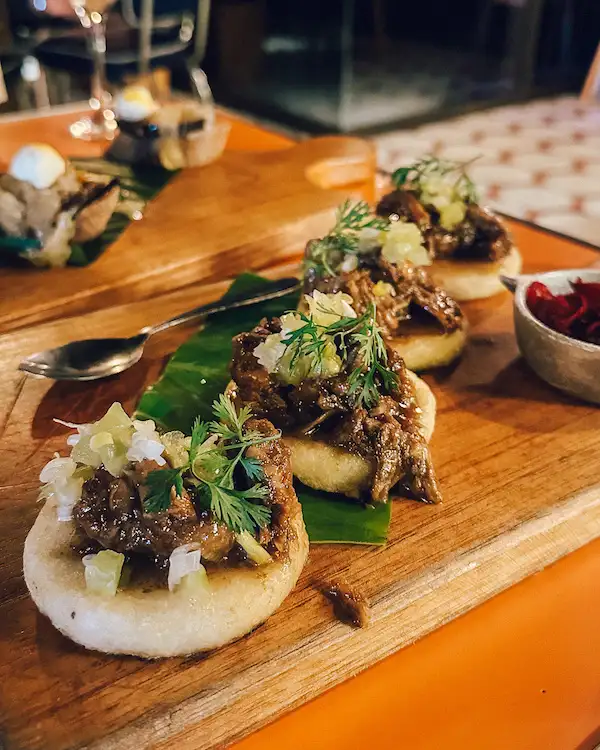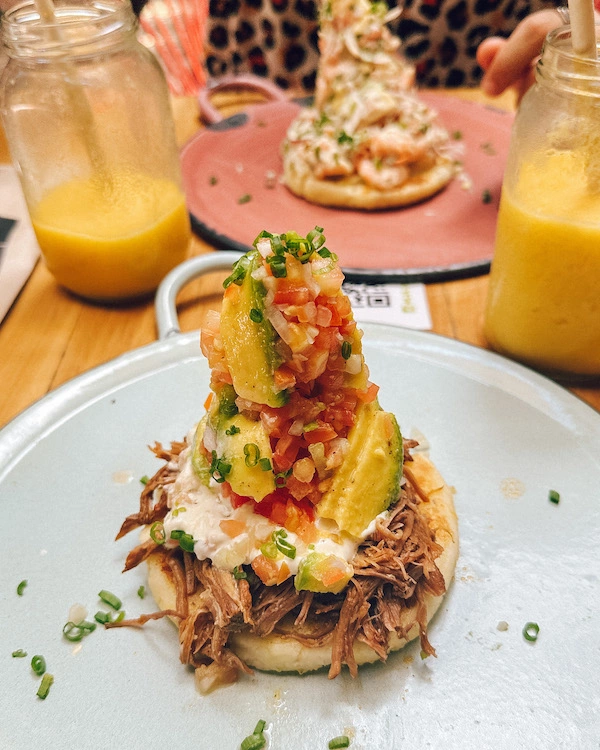I first ate an Arepa in Cartagena de Indias in Colombia, and I fell in love immediately.
I was standing in a sliver of shade cast by a colonial mansion in the walled city, trying to decide what to eat. I continued around the city walls, determined not to spend fortunes inside the overpriced restaurants in the historic center.
Salvation only came from outside the walls, in the bustling city center, from the hands of a man who shouted:
Two arepas and a juice for 4500 pesos.
Upon the first bite of the first arepa, two things became clear to me:
- one arepa only would have been more than enough to satisfy my hunger
- I wanted to eat arepas every day for the rest of my life.
What exactly are arepas?
An arepa is a flat, round, unleavened patty made of ground maize dough or cooked flour. And it is in this simple recipe that the genius of the dish lies.
Think of it as a canvas, ready to be painted with various flavors. The beauty of arepas lies in their simplicity and versatility. You can have them for breakfast, lunch, dinner, or even as a snack.
The mild flavor and the soft texture that delicately blends with the melted cheese inside explain why this is one of the greatest gastronomic icons not only of Colombia but also of neighboring Venezuela, a country with which it engages in a not-so-silent dispute for recognition of the dish.
The magic formula of the arepa dates back to the indigenous people who inhabited the region long before colonization when there was no knowledge of things like borders and customs posts.


How are arepas made?
Ingredients:
- 2 cups of pre-cooked corn flour (like P.A.N. or another brand)
- 2 to 2 1/2 cups of water
- 1 teaspoon of salt
- Butter or oil for grilling (optional)
- Cheese, meat, avocado, or filling of your choice (optional)
Instructions:
- In a large bowl, add salt to the water and mix until dissolved.
- Gradually add the corn flour to the salted water, stirring constantly to prevent lumps. Keep adding and stirring until you get a dough that does not stick to your hands. If it’s too dry, add a bit more water; if it’s too wet, add a bit more flour.
- Let the dough rest for about 5-10 minutes to allow the corn flour to absorb the water.
- Divide the dough into portions the size of a golf ball (or larger, if you prefer). Shape each portion into a flat disc about 1 cm thick. Make sure the edges are smooth to prevent them from breaking while cooking.
- Heat a skillet or grill over medium-high heat. If desired, you can add a bit of butter or oil for grilling the arepas (this is optional, as some people cook arepas in a dry pan).
- Place the arepas in the hot skillet and cook for about 5-7 minutes on each side, or until they are golden and crispy on the outside and soft inside.
- Once cooked, remove the arepas from the skillet and let them cool for a few minutes before serving.
- If desired, you can split the arepas and stuff them with cheese, meat, avocado, or any other filling of your choice.
- Serve while still hot!
What are the most popular fillings for arepas?
Oh, the endless possibilities! Shredded beef, cheese, beans, avocado… and the list goes on! The choice of filling transforms the humble arepa into a culinary delight, catering to diverse palates.
Cheese is arguably the most classic and universally loved filling. Whether it’s a simple white cheese in Colombia or the meltier varieties in Venezuela, cheese-filled arepas are a crowd-pleaser. The cheese can be mixed into the dough or melted inside as a filling.
Shredded Beef (Carne Mechada), black beans and avocado and Chicken (Reina Pepiada) are popular choices in Venezuela, while Scrambled Eggs (Perico) and spicy chorizo and Beans are the favorites in Colombia
Although not very traditional, vegetarian and vegan options are becoming increasingly popular. Fillings like grilled vegetables, plant-based meats, and vegan cheeses can now be found anywhere, catering to a broader audience.
What’s the difference between Colombian and Venezuelan arepas?
Even though the origin of arepas are the same, over the centuries, each country has found its own way to make the arepa more its own.
In Venezuela, the little bread is often used as the base of a sandwich, with a cut in the middle to hold the filling. In Colombia, it can take the form of a stuffed cake or a biscuit, served as an accompaniment to various dishes.
There are also regional variations within the countries, with each corner inventing its own way of eating arepa. However, the dish’s versatility stays the same on both sides of the border: it is served for breakfast, lunch, and dinner. Every time is Arepa time.
Cornbreads are typical in Latin America. Each country has its unique take on this staple, creating a fascinating variety of dishes. But the arepa has nothing to do with Mexico’s ubiquitous corn tortillas. The raw material may be the same, but tortillas are thin and used to accompany and, sometimes, even as the ‘wrapping’ of the main dish.
Arepas, on the other hand, are more like bread and are the stars of the meal. Fillings are welcome and can vary according to the chef’s creativity, but the arepa is auto-sufficient.
Is there a sweet version of arepas?
Yes! Sweet arepas are a delightful twist on the traditional recipe, showcasing the adaptability of this iconic dish.
Unlike their savory counterparts, typically filled with cheese, meats, or beans, sweet arepas indulge the palate with sugary, dessert-like fillings and ingredients.
Key Variations of Sweet Arepas:
- Arepas de Choclo:
- A Colombian favorite, arepas de choclo are made from sweet corn. They are softer and have a naturally sweet taste, often served with butter or cheese for a delightful contrast.
- Arepas Dulces:
- In Venezuela and other parts, arepas dulces (sweet arepas) are made by adding sugar, anise seeds, and sometimes cinnamon to the dough. They can be enjoyed as is, or topped with cheese, which melts beautifully and offers a salty-sweet combination.
- Filled Sweet Arepas:
- Some sweet arepas come filled or topped with indulgent ingredients like dulce de leche, guava paste, or sweetened cream cheese. These fillings transform the arepa into a dessert-like treat, perfect for satisfying a sweet tooth.
- Fruit-Topped Arepas:
- Another way to enjoy sweet arepas is to top them with fresh fruits, jams, or compotes. This variation is especially popular as a breakfast item or a light dessert.
Sweet arepas are not just an everyday treat; they often grace the table during festivals, holidays, and special occasions. They offer a delightful end to a meal or a sweet snack during celebrations.
Check out our Guide to the Digital Nomad in Medellín!
Editor of Yes, Summer! I am a Brazilian journalist, writer, and digital nomad. I have been traveling the world, telling stories, and tasting local beers since 2010. I am the co-founder of 360meridianos, a reference in travel writing in Brazil, and author of the newsletter Migraciones. On social media, I'm always reachable at @natybecattini.
